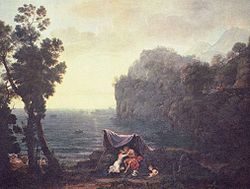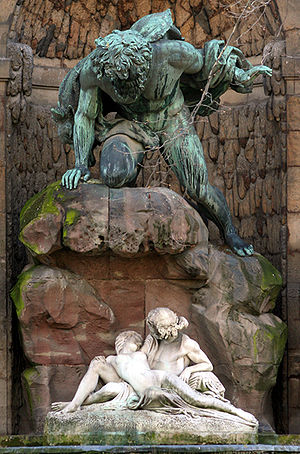.gif)
Acis and Galatea (mythology)
Encyclopedia
- For other meanings, see ACIS (disambiguation)ACIS (disambiguation)ACIS may refer to:* ACIS , a solid modelling geometric modeling kernel that several CAD packages use* Advanced CCD Imaging Spectrometer, an instrument on NASA's Chandra X-ray Observatory...
In Ovid
Ovid
Publius Ovidius Naso , known as Ovid in the English-speaking world, was a Roman poet who is best known as the author of the three major collections of erotic poetry: Heroides, Amores, and Ars Amatoria...
's Metamorphoses
Metamorphoses (poem)
Metamorphoses is a Latin narrative poem in fifteen books by the Roman poet Ovid describing the history of the world from its creation to the deification of Julius Caesar within a loose mythico-historical framework. Completed in AD 8, it is recognized as a masterpiece of Golden Age Latin literature...
, Acis (Greek
Greek language
Greek is an independent branch of the Indo-European family of languages. Native to the southern Balkans, it has the longest documented history of any Indo-European language, spanning 34 centuries of written records. Its writing system has been the Greek alphabet for the majority of its history;...
: Άκις) was the spirit of the Acis River
Acireale
Acireale is a coastal city and commune in the north-east of the province of Catania, Sicily, Italy, at the foot of Mount Etna, on the coast facing the Ionian Sea. It is a diocese, famous for its churches, including the Neo-Gothic St. Peter's Basilica, St...
in Sicily
Sicily
Sicily is a region of Italy, and is the largest island in the Mediterranean Sea. Along with the surrounding minor islands, it constitutes an autonomous region of Italy, the Regione Autonoma Siciliana Sicily has a rich and unique culture, especially with regard to the arts, music, literature,...
, beloved of the nereid, or sea-nymph, Galatea (Γαλάτεια; "she who is milk-white"). Galatea returned the love of Acis, but a jealous suitor, the Sicilian Cyclops
Cyclops
A cyclops , in Greek mythology and later Roman mythology, was a member of a primordial race of giants, each with a single eye in the middle of his forehead...
Polyphemus
Polyphemus
Polyphemus is the gigantic one-eyed son of Poseidon and Thoosa in Greek mythology, one of the Cyclopes. His name means "much spoken of" or "famous". Polyphemus plays a pivotal role in Homer's Odyssey.-In Homer's Odyssey:...
, killed him with a boulder. Distraught, Galatea then turned his blood into the river Acis. The Acis River flowed past Akion (Acium) near Mount Etna
Mount Etna
Mount Etna is an active stratovolcano on the east coast of Sicily, close to Messina and Catania. It is the tallest active volcano in Europe, currently standing high, though this varies with summit eruptions; the mountain is 21 m higher than it was in 1981.. It is the highest mountain in...
in Sicily.
Details

According to Ovid's Metamorphoses, Acis was the son of Faunus
Faunus
In ancient Roman religion and myth, Faunus was the horned god of the forest, plains and fields; when he made cattle fertile he was called Inuus. He came to be equated in literature with the Greek god Pan....
and the river-nymph
Naiad
In Greek mythology, the Naiads or Naiades were a type of nymph who presided over fountains, wells, springs, streams, and brooks....
Symaethis, daughter of the River Symaethus.

Athenaeus
Athenaeus , of Naucratis in Egypt, Greek rhetorician and grammarian, flourished about the end of the 2nd and beginning of the 3rd century AD...
, ca 200 CE the story was first concocted as a political satire against the Sicilian tyrant Dionysius I of Syracuse
Dionysius I of Syracuse
Dionysius I or Dionysius the Elder was a Greek tyrant of Syracuse, in what is now Sicily, southern Italy. He conquered several cities in Sicily and southern Italy, opposed Carthage's influence in Sicily and made Syracuse the most powerful of the Western Greek colonies...
, whose favourite concubine, Galatea, shared her name with a nereid mentioned by Homer
Homer
In the Western classical tradition Homer , is the author of the Iliad and the Odyssey, and is revered as the greatest ancient Greek epic poet. These epics lie at the beginning of the Western canon of literature, and have had an enormous influence on the history of literature.When he lived is...
. Others claim the story was invented to explain the presence of a shrine dedicated to Galatea on Mount Etna.
A first-century fresco removed from an Imperial villa at Boscotrecase
Boscotrecase
Boscotrecase is a comune in the Province of Naples in the Italian region Campania, located about 20 km southeast of Naples...
, preserved by the eruption of Vesuvius, and now at the Metropolitan Museum of Art
Metropolitan Museum of Art
The Metropolitan Museum of Art is a renowned art museum in New York City. Its permanent collection contains more than two million works, divided into nineteen curatorial departments. The main building, located on the eastern edge of Central Park along Manhattan's Museum Mile, is one of the...
shows the three figures as incidents in a landscape.
Cultural references
The tale of Acis and Galatea was familiar from the Renaissance
Renaissance
The Renaissance was a cultural movement that spanned roughly the 14th to the 17th century, beginning in Italy in the Late Middle Ages and later spreading to the rest of Europe. The term is also used more loosely to refer to the historical era, but since the changes of the Renaissance were not...
onwards: there are paintings of the subject, sometimes as mythological incidents in a large landscape, by Adam Elsheimer
Adam Elsheimer
Adam Elsheimer was a German artist working in Rome who died at only thirty-two, but was very influential in the early 17th century. His relatively few paintings were small scale, nearly all painted on copper plates, of the type often known as cabinet paintings. They include a variety of light...
. Nicolas Poussin
Nicolas Poussin
Nicolas Poussin was a French painter in the classical style. His work predominantly features clarity, logic, and order, and favors line over color. His work serves as an alternative to the dominant Baroque style of the 17th century...
(National Gallery of Ireland
National Gallery of Ireland
The National Gallery of Ireland houses the Irish national collection of Irish and European art. It is located in the centre of Dublin with one entrance on Merrion Square, beside Leinster House, and another on Clare Street. It was founded in 1854 and opened its doors ten years later...
), and Claude Lorrain
Claude Lorrain
Claude Lorrain, , traditionally just Claude in English Claude Lorrain, , traditionally just Claude in English (also Claude Gellée, his real name, or in French Claude Gellée, , dit le Lorrain) Claude Lorrain, , traditionally just Claude in English (also Claude Gellée, his real name, or in French...
(Dresden).
In music, the story was the basis for Lully's Acis et Galatée
Acis et Galatée
Acis et Galatée is an opera by Jean-Baptiste Lully. Unlike most of his operas, which are designated tragédies en musique, Lully called this work a pastorale-héroïque, because it was on a pastoral theme and had only three acts compared to the usual five...
. Handel created both Acis and Galatea and Aci, Galatea e Polifemo
Aci, Galatea e Polifemo
Aci, Galatea e Polifemo is a dramatic cantata—also called a serenata—by George Frederic Handel. It was first performed at Naples on 19 July 1708; the completed score is dated to 16 June 1708...
on the story and Antonio de Literes
Antonio de Literes
Antonio de Literes was a Spanish composer of zarzuelas, a type of performance that mixes spoken word, song and dance...
wrote the zarzuela
Zarzuela
Zarzuela is a Spanish lyric-dramatic genre that alternates between spoken and sung scenes, the latter incorporating operatic and popular song, as well as dance...
Acis y Galatea. Nicola Porpora
Nicola Porpora
Nicola Porpora was an Italian composer of Baroque operas and teacher of singing, whose most famous singing student was the castrato Farinelli. One of his other students was composer Matteo Capranica.-Biography:Porpora was born in Naples...
's opera Polifemo and Jean Cras
Jean Cras
Jean Émile Paul Cras was a 20th century French composer and career naval officer. His musical compositions were inspired by his native Brittany, his travels to Africa, and most of all, by his sea voyages...
's opera Polyphème
Polyphème
Polyphème is an opera composed by Jean Cras with a libretto by Albert Samain. It was written by Cras during World War I and was premiered in Paris in 1922, giving Cras a burst of notoriety in the French press.-Text:...
are also based on the story.
Claude Lorrain's painting of Acis and Galatea inspired Fyodor Dostoevsky
Fyodor Dostoevsky
Fyodor Mikhaylovich Dostoyevsky was a Russian writer of novels, short stories and essays. He is best known for his novels Crime and Punishment, The Idiot and The Brothers Karamazov....
's description of the 'Golden Age'; explicitly in 'A Raw Youth' and in Stavrogin's dream in 'The Devils', and implicitly in 'The Dream of a Ridiculous Man'.

